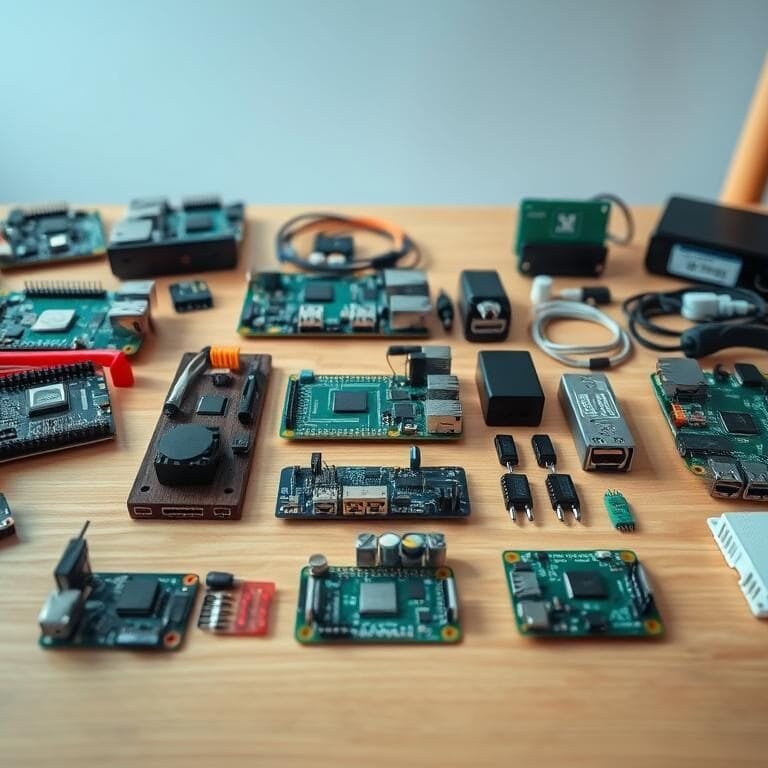Now you can dive into the world of meteorology with a fun and educational project: making your own DIY Weather Station. Home weather monitoring has become popular. People can now track temperature, pressure, and humidity from their homes.
The Challenger Project’s Weather Station on Cratejoy is a great DIY kit. It lets you learn about atmospheric science by doing it yourself. By making your own weather monitoring system, you’ll understand weather patterns better. You’ll also learn important skills in observing and analyzing data.
Key Takeaways
- Create a personalized weather monitoring system at home.
- Gain hands-on experience in atmospheric science with a DIY kit.
- Track temperature, pressure, and humidity with ease.
- Develop essential skills in observation and data analysis.
- Enhance your understanding of weather patterns and their impact.
What Is a Weather Station?
A weather station is a group of tools that measure and record the weather. It includes thermometers for temperature, hygrometers for humidity, anemometers for wind speed, and barometers for pressure.
Definition and Purpose
A weather station gives accurate data on weather conditions. This info is key for meteorologists, researchers, and weather fans. They use it to understand and forecast weather.
Key features of a weather station include:
- Measuring temperature, humidity, wind speed, and atmospheric pressure
- Recording data over time for analysis
- Providing real-time data for immediate weather monitoring
Types of Weather Stations
There are many types of weather stations for different needs. Here are a few:
- Outdoor weather stations are for outside use, giving direct weather readings.
- Wireless weather stations send data wirelessly, making it easy to monitor weather.
- Digital weather stations offer precise digital readings and extra features like forecasts and alerts.
| Type of Weather Station | Key Features | Use Case |
|---|---|---|
| Outdoor Weather Station | Durable, weather-resistant, measures temperature, humidity, wind speed | Ideal for backyard installation, providing direct weather data |
| Wireless Weather Station | Wireless data transmission, easy to install, real-time data | Suitable for home use, educational projects, and research |
| Digital Weather Station | Precise digital readings, forecasting, alerts | Best for those needing detailed weather data and analysis |
Benefits of Building Your Own Weather Station
Creating a home weather station is more than a DIY project. It’s a chance to dive into meteorology hands-on. By making your own weather station, you get many benefits that improve your weather forecasting skills.
Hands-On Learning Experience
Building your own weather station offers a unique learning experience. Experts say it boosts critical thinking and data analysis skills. This practical learning is key for anyone into meteorology, showing how to collect and analyze weather data.
You’ll learn how to measure and record various weather factors. This knowledge helps you understand weather data better. It also lets you make smarter decisions based on that data.
Real-Time Data Collection
A home weather station lets you gather real-time weather data. This gives you insights into the current weather. You can track temperature, humidity, wind speed, and more as they change.
Collecting real-time data is key for local weather patterns and predictions. With current data, you can spot trends and oddities. This improves your forecasting abilities.
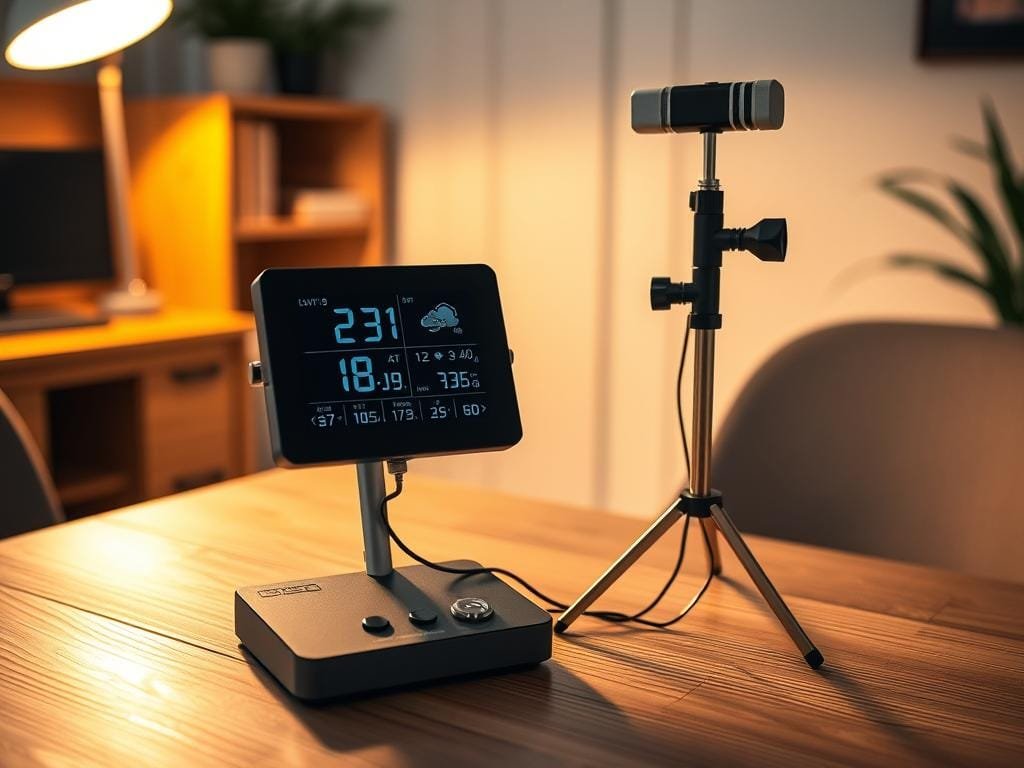
Cost-Effective Solutions
Building your own weather station can save money compared to buying a commercial one. By choosing the right parts and setting them up right, you can make a weather station that fits your budget.
This DIY approach also lets you upgrade or change your station as needed. This flexibility is great for keeping up with new weather tech.
In summary, making your own weather station has many perks. You get hands-on learning, real-time data, and it’s cost-effective. By taking on this DIY project, you can learn more about meteorology and get better at predicting the weather.
Essential Components of a Weather Station
To make a weather station work, you need to know its key parts. A weather station is a complex system. It uses different parts to get and share weather data right.
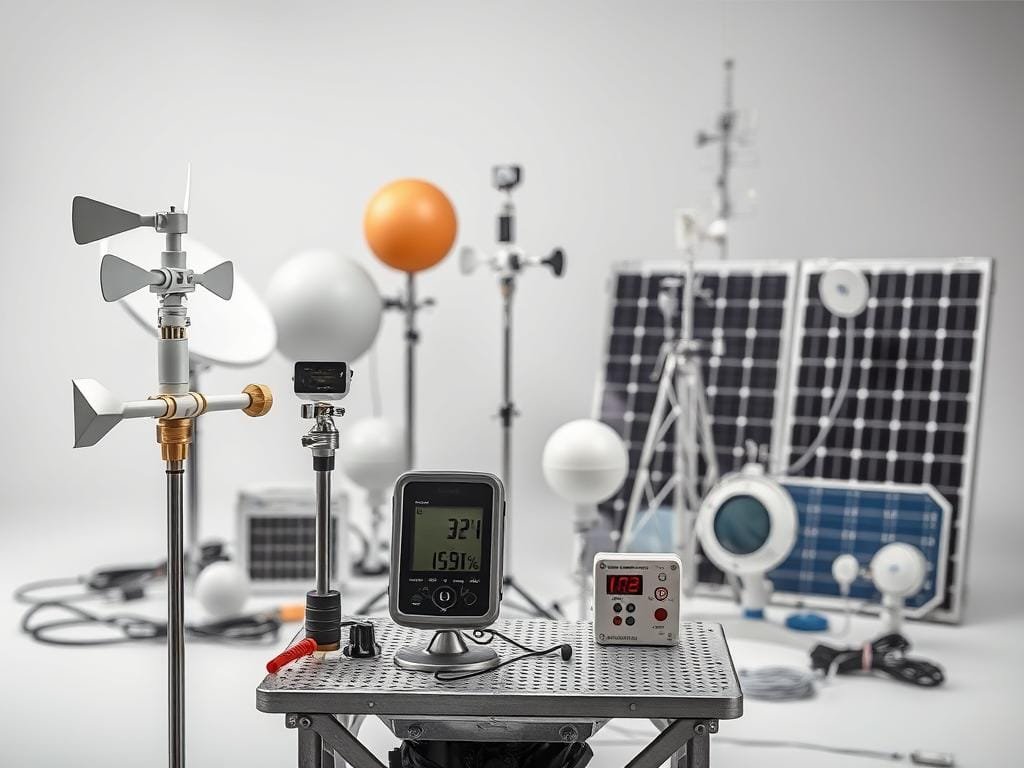
Sensors You Need
The heart of a weather station is its sensors. These tools measure things like temperature, humidity, wind speed, and rain. A basic weather station might have:
- Anemometer: Measures wind speed.
- Wind Vane: Finds wind direction.
- Rain Gauge: Tracks rain.
- Thermometer: Checks temperature.
- Hygrometer: Sees humidity.
Sensors can be analog or digital. Digital sensors are more common today. They’re more accurate and easier to use with data loggers.
Data Logger Options
A data logger is key for saving sensor data. It keeps the info and often sends it to a place for study. Think about:
- Memory Capacity: Make sure it can hold data for a good while.
- Connectivity: Wi-Fi, Ethernet, or cell might be needed based on your needs.
- Power Consumption: This is important if you’re using batteries or solar panels.
Some data loggers come with software. This makes it easier to see and understand the data.
Power Supply Requirements
The power source for your weather station depends on its parts and where it’s set up. You can use:
- Batteries: Good for low-power stuff.
- Solar Panels: Great for places far from power or to save money.
- Mains Power: Best if your station is near a power source for reliability.
Choose a power supply that fits your station’s power needs and any future growth.
By picking the right parts, you can build a digital weather station. It can be for fun, research, or school.
Tools Required for Assembly
To build your own weather station, you’ll need the right tools. The right tools make assembly easier and ensure your station works well.
Basic Hand Tools
For the start of assembling your weather station, you’ll need basic hand tools. These include:
- Screwdrivers (flathead and Phillips)
- Pliers (needle-nose and slip-joint)
- Wire cutters and strippers
- A drill with various drill bits
Advanced Equipment
For more complex tasks or to improve your station, you might need advanced tools. This includes:
- A soldering iron and solder for connecting components
- A multimeter for testing electrical connections
- A weatherproof enclosure for protecting your equipment
Having the right tools is key for a successful weather station. The table below lists some important tools and their uses:
| Tool | Use |
|---|---|
| Screwdrivers | Assembling and disassembling parts |
| Pliers | Gripping and bending components |
| Soldering Iron | Connecting electronic components |
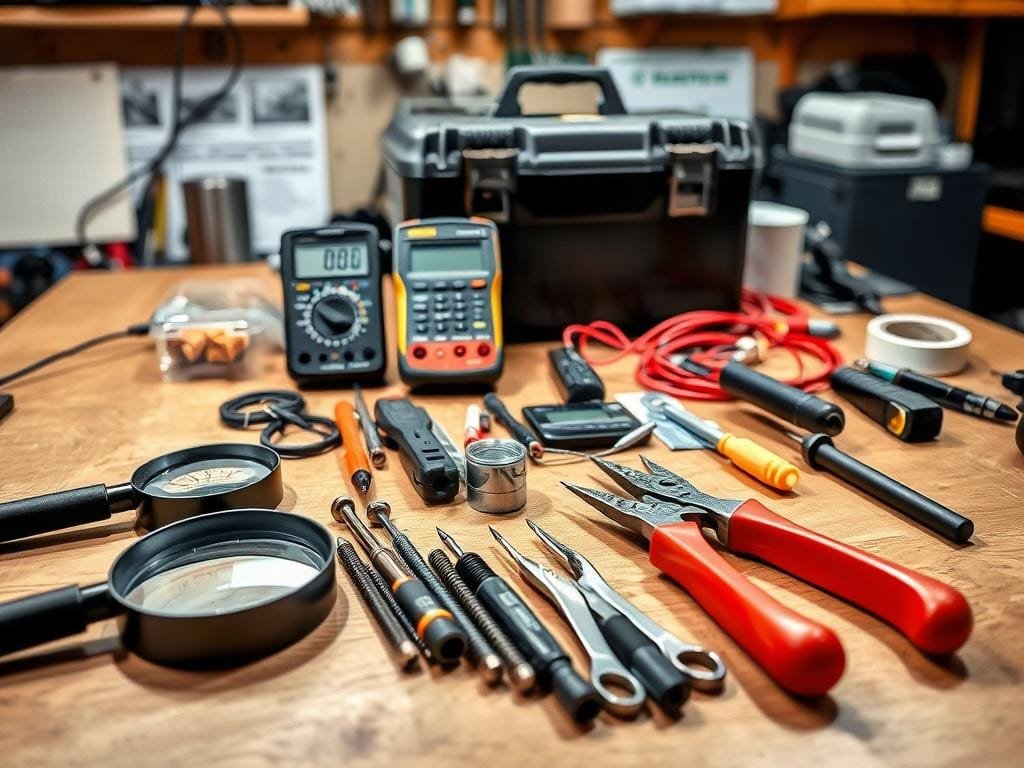
Choosing the Right Location for Your Station
To make sure your weather station works well, choosing the right location is key. The data it collects depends a lot on where it’s placed.
Location is very important. A good spot for your weather station can give you important info on local weather. This info is useful for both personal and work uses. Studies show that local weather can tell us a lot about the bigger climate trends. So, where you put your weather station is very important for understanding weather data.
Importance of Location
The spot you pick for your weather station affects how it deals with things like wind, rain, and sun. Good placement means your station can get accurate data. For example, a shaded spot might keep your station cool, but it might not show the real sun levels in the area.
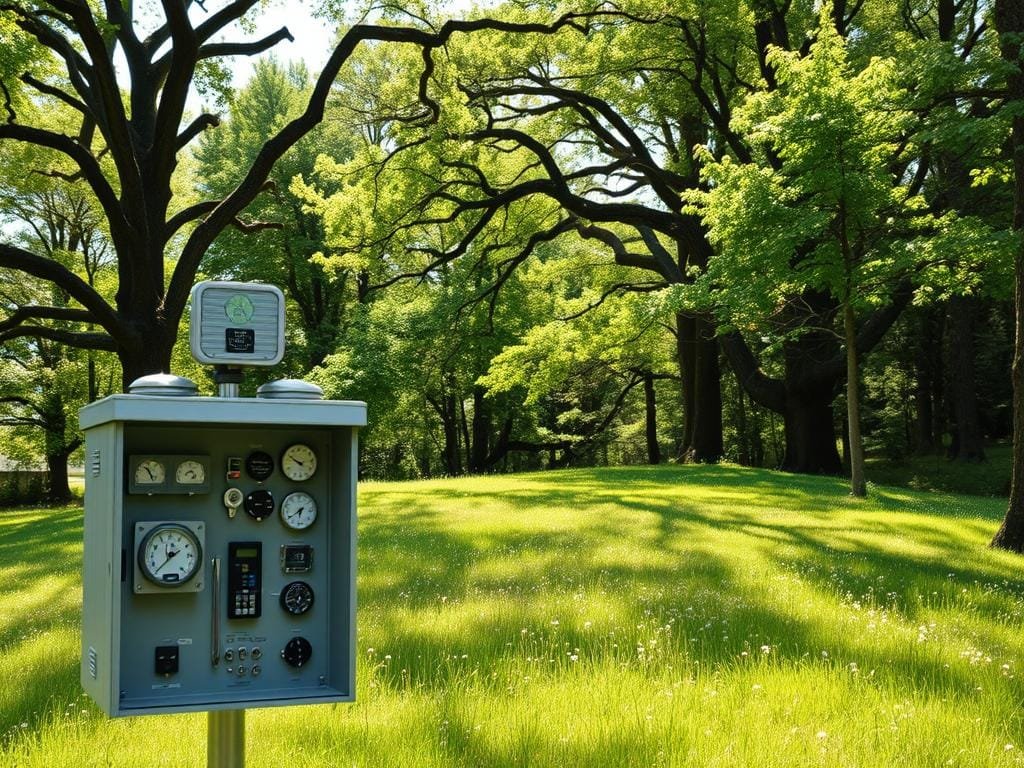
Factors to Consider
When picking a spot for your outdoor weather station, think about a few things. These include:
- How close it is to things like buildings, trees, or other structures that might mess with wind or sun.
- The local landscape, like hills, valleys, or water, can change the weather in your area.
- The surface around it, like grass, concrete, or water, can affect the temperature and other data.
By thinking about these points, you can find the best spot for your weather station. The aim is to put it somewhere that shows what the weather is like in your area.
Installing Your Weather Station
Setting up your weather station is key to getting accurate data. A well-set weather station gives you reliable data for forecasting and research.
Step-by-Step Setup Guide
To install your weather station right, follow these steps:
- Choose the right location: Pick a spot that’s open and free from trees or buildings.
- Assemble the sensors: Follow the maker’s guide to put together the sensors, like the anemometer, rain gauge, and temperature sensor.
- Mount the sensors: Attach the sensors to a strong structure, like a mast or roof.
- Connect the sensors to the data logger: Use the cables given to link the sensors to the data logger.
- Configure the data logger: Set up the data logger as the maker says, choosing how often to collect data and more.
Check out the Challenger Project – Weather Station kit for a detailed DIY guide on setting up your weather station.
Common Installation Mistakes to Avoid
When setting up your weather station, watch out for these common mistakes:
- Insufficient grounding: Make sure your weather station is well-grounded to avoid damage from lightning.
- Incorrect sensor placement: Don’t place sensors near buildings or plants that might affect them.
- Inadequate cable management: Keep cables safe from weather and animals by securing them well.
Avoiding these mistakes helps your weather station work well and give you accurate data.
| Installation Step | Common Mistakes | Prevention Tips |
|---|---|---|
| Sensor Assembly | Incorrect assembly | Follow manufacturer’s instructions |
| Sensor Mounting | Insecure mounting | Use sturdy structures and secure fasteners |
| Data Logger Configuration | Incorrect settings | Refer to manufacturer’s guide and test settings |
Data Analysis and Interpretation
Analyzing data from your weather station can show interesting trends and patterns in your local weather. As you start collecting data, you’ll need to understand what it means and how to show it well.
Your weather station collects data like temperature, humidity, wind speed, and atmospheric pressure. Understanding these elements is key for interpreting weather patterns. For example, a sudden drop in pressure might mean a storm is coming. Consistent temperature readings can help track seasonal changes.
Understanding Weather Data
To make sense of your data, first understand the different types of information your weather station collects. Here’s a breakdown of key data points and their significance:
| Data Point | Description | Significance |
|---|---|---|
| Temperature | Measures the current air temperature. | Helps track daily and seasonal temperature changes. |
| Humidity | Measures the amount of moisture in the air. | Important for predicting weather like fog or rain. |
| Wind Speed | Measures how fast the wind is blowing. | Crucial for understanding weather patterns and storms. |
By looking at these data points, you can understand local weather trends better. For example, consistent monitoring can help spot patterns before severe weather.
Using Software for Visualization
Using digital tools and software can greatly improve your ability to analyze and show weather data. Many modern weather stations come with apps or software to help interpret data better.
Some popular features of weather station software include:
- Graphical representation of data trends
- Customizable alerts for specific weather conditions
- Historical data storage for long-term analysis
By using these tools, you can turn raw data into useful insights and forecasts. For example, showing temperature trends over time can help you prepare for extreme weather.
In conclusion, analyzing and interpreting data from your digital weather station is a powerful way to understand local weather patterns. By knowing weather data and using the right software, you can make better decisions and even help with weather forecasting.
Connecting to Online Networks
Connecting your weather station to online networks opens up a world of possibilities. You can share data and collaborate with others. This way, you join a community of weather enthusiasts and gain access to a lot of information.
Benefits of Sharing Data
Sharing data through online weather networks has many benefits. It lets you:
- Contribute to crowdsourced weather maps that help understand larger weather patterns.
- Join weather forecasting communities where you can discuss and learn from others.
- Access historical data for research and personal interest.
Many modern weather stations can sync data to online platforms. This feature allows remote monitoring and analysis of historical data. It makes it easier to track changes and trends over time.
Some popular weather networks are for amateur meteorology and weather enthusiasts. By joining these networks, you can:
- Share your data with a wider community.
- Compare your findings with data from other locations.
- Enhance your understanding of weather patterns through collaborative efforts.
Using a weather station with an app makes connecting to online networks easier. Many apps offer an easy-to-use interface for monitoring your weather station’s data. They also help share it with various weather networks.
Maintenance Tips for Your Weather Station
Keeping your weather station in good shape is key for accurate weather tracking. A well-maintained station gives you reliable data for forecasting and analysis.
Regular Checks and Calibrations
Regular checks are vital for your weather station’s correct operation. Look for any damage or debris on the sensors. Calibration is also important to ensure accurate readings. For example, the anemometer, which measures wind speed, needs regular calibration to maintain accuracy.
Calibration Steps:
- Check the manufacturer’s instructions for calibration procedures.
- Compare your weather station’s readings with those from a nearby official weather station.
- Adjust the sensors as necessary to align with the official readings.
Regular calibration boosts accuracy and extends your weather station’s life.
Troubleshooting Common Issues
Even with regular maintenance, problems can pop up. Issues like incorrect readings, equipment failure, and connectivity problems are common. Fixing these problems is essential for your weather station’s performance.
| Issue | Cause | Solution |
|---|---|---|
| Inaccurate Temperature Readings | Sensor damage or debris | Inspect and clean or replace the sensor |
| Equipment Failure | Power supply issues or worn-out components | Check the power supply and replace faulty components |
| Connectivity Issues | Poor internet connection or software glitches | Restart the system and check internet connectivity |
By following these troubleshooting steps, you can fix common problems. This ensures your weather station keeps working well.
Maintaining your weather station is an ongoing task that needs attention and a proactive mindset. Regular checks, calibrations, and troubleshooting keep your station reliable for weather data.
Enhancing Your Weather Station
Now that your weather station is set up, it’s time to think about making it better. You can get more accurate and varied data by adding new features.
Adding More Sensors and Features
Think about adding more sensors to your weather station. This will help you collect more data. Here are some ideas:
- Soil moisture sensors to check the ground’s moisture
- UV sensors to measure UV radiation levels
- Noise pollution sensors to track ambient noise
You can also look into ambient computing. This lets you connect your weather station with other smart devices.
Integration with Smart Home Devices
Connecting your weather station with smart home devices can make it more useful. For example, you can link it to your home automation system. This lets you:
- Adjust your heating and cooling based on outside temperature
- Control outdoor lights based on daylight changes
- Get alerts on your phone for certain weather conditions
To learn more about customizing your weather station, check out Ambient Weather’s guide on making your own weather station.
By improving your weather station, you can make a more advanced system. This system will give you deeper insights into your local environment.
Future of Amateur Meteorology
As you work on your weather station, you’re helping grow amateur meteorology. This field is changing fast. New tech is making forecasts more accurate and bringing people together.
Advancements in Weather Monitoring
New tech is making weather stations better. They can collect data more precisely and in real-time. This is key for the future of weather forecasting. It helps you make better choices based on local weather.
Community-Driven Weather Networks
Community weather networks are also growing. By linking your station to these networks, you share data and get insights. This makes local forecasts more accurate and helps us understand weather better.
Amateur meteorology is getting more important. Weather stations will play a bigger role in forecasting. By using new tech and joining community networks, you help shape the future of weather forecasting.
FAQ
What is the primary function of a weather station?
A weather station measures weather parameters like temperature, humidity, and wind speed. It also tracks atmospheric pressure. This gives us accurate weather data.
What are the benefits of building my own weather station?
Building your own weather station is a hands-on learning experience. It lets you collect data in real-time. Plus, it’s a cost-effective way for aspiring meteorologists.
What type of sensors do I need for a weather station?
You’ll need sensors for temperature, humidity, wind speed, and direction. Also, for atmospheric pressure. Some stations also track rainfall, UV radiation, and soil moisture.
How do I choose the right location for my weather station?
Choose a spot that’s exposed to elements but not too close to obstacles. Also, consider the local topography. This ensures your data is accurate.
Can I connect my weather station to online networks?
Yes, connecting your station to online networks lets you share data. You can also collaborate with other enthusiasts. Plus, you can join community weather projects.
How do I maintain my weather station?
Regular checks and calibrations are key. Troubleshooting common issues is also important. This keeps your station accurate and reliable.
Can I enhance my weather station with additional features?
Yes, you can add more sensors or integrate it with smart home devices. Exploring new features can also expand its capabilities.
What are the benefits of using a wireless weather station?
Wireless stations offer flexibility and convenience. You can place sensors anywhere without cables. This makes setup easier.
How accurate are digital weather stations?
Digital stations can be very accurate if well-calibrated and maintained. The data’s quality depends on the sensors and the station’s design.
Can I use a weather station with a smartphone app?
Yes, many modern stations come with apps. These apps let you monitor data remotely, get alerts, and access extra features.



